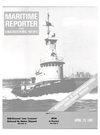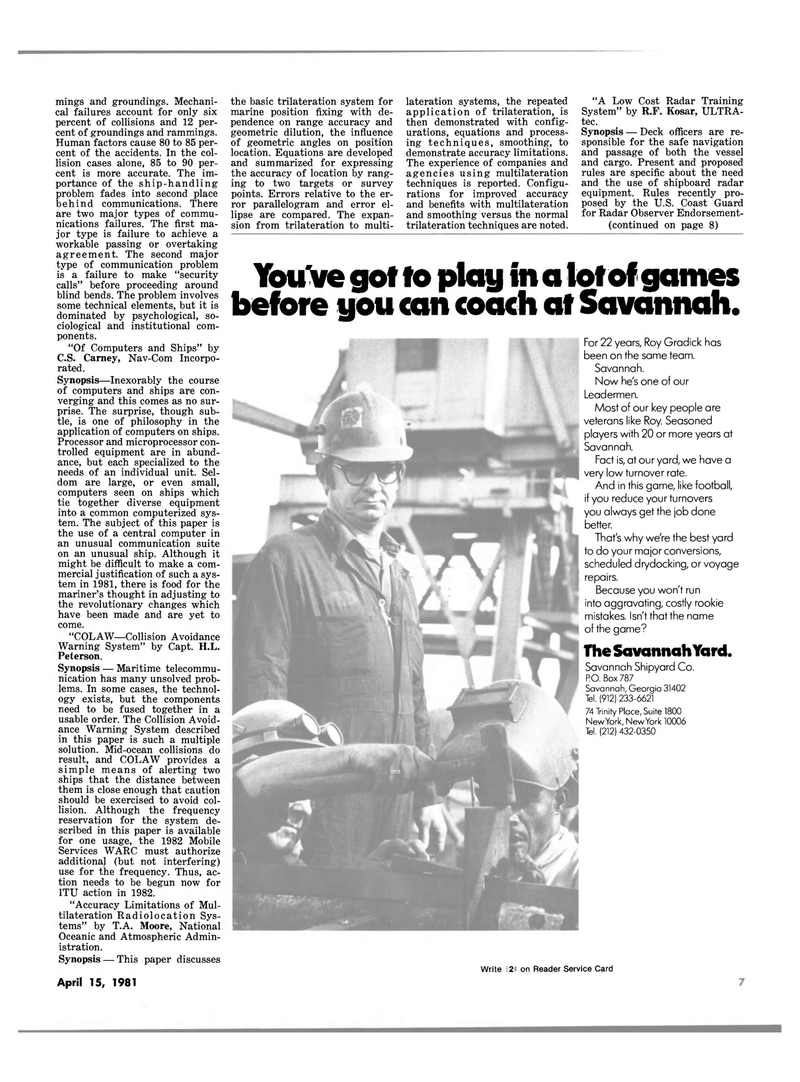
Page 5: of Maritime Reporter Magazine (April 15, 1981)
Read this page in Pdf, Flash or Html5 edition of April 15, 1981 Maritime Reporter Magazine
mings and groundings. Mechani- cal failures account for only six percent of collisions and 12 per- cent of groundings and rammings.
Human factors cause 80 to 85 per- cent of the accidents. In the col- lision cases alone, 85 to 90 per- cent is more accurate. The im- portance of the ship-handling problem fades into second place behind communications. There are two major types of commu- nications failures. The first ma- jor type is failure to achieve a workable passing or overtaking agreement. The second major type of communication problem is a failure to make "security calls" before proceeding around blind bends. The problem involves some technical elements, but it is dominated by psychological, so- ciological and institutional com- ponents. "Of Computers and Ships" by
C.S. Carney, Nav-Com Incorpo- rated.
Synopsis—Inexorably the course of computers and ships are con- verging and this comes as no sur- prise. The surprise, though sub- tle, is one of philosophy in the application of computers on ships.
Processor and microprocessor con- trolled equipment are in abund- ance, but each specialized to the needs of an individual unit. Sel- dom are large, or even small, computers seen on ships which tie together diverse equipment into a common computerized sys- tem. The subject of this paper is the use of a central computer in an unusual communication suite on an unusual ship. Although it might be difficult to make a com- mercial justification of such a sys- tem in 1981, there is food for the mariner's thought in adjusting to the revolutionary changes which have been made and are yet to come. "COLAW—Collision Avoidance
Warning System" by Capt. H.L.
Peterson.
Synopsis — Maritime telecommu- nication has many unsolved prob- lems. In some cases, the technol- ogy exists, but the components need to be fused together in a usable order. The Collision Avoid- ance Warning System described in this paper is such a multiple solution. Mid-ocean collisions do result, and COLAW provides a simple means of alerting two ships that the distance between them is close enough that caution should be exercised to avoid col- lision. Although the frequency reservation for the system de- scribed in this paper is available for one usage, the 1982 Mobile
Services WARC must authorize additional (but not interfering) use for the frequency. Thus, ac- tion needs to be begun now for
ITU action in 1982. "Accuracy Limitations of Mul- tilateration Radiolocation Sys- tems" by T.A. Moore, National
Oceanic and Atmospheric Admin- istration.
Synopsis — This paper discusses
April 15, 1981 the basic trilateration system for marine position fixing with de- pendence on range accuracy and geometric dilution, the influence of geometric angles on position location. Equations are developed and summarized for expressing the accuracy of location by rang- ing to two targets or survey points. Errors relative to the er- ror parallelogram and error el- lipse are compared. The expan- sion from trilateration to multi- lateration systems, the repeated application of trilateration, is then demonstrated with config- urations, equations and process- ing techniques, smoothing, to demonstrate accuracy limitations.
The experience of companies and agencies using multilateration techniques is reported. Configu- rations for improved accuracy and benefits with multilateration and smoothing versus the normal trilateration techniques are noted. "A Low Cost Radar Training
System" by R.F. Kosar, ULTRA- tec.
Synopsis — Deck officers are re- sponsible for the safe navigation and passage of both the vessel and cargo. Present and proposed rules are specific about the need and the use of shipboard radar equipment. Rules recently pro- posed by the U.S. Coast Guard for Radar Observer Endorsement- continued on page 8)
You've got to play in a lot of games before you can coach at Savannah.
For 22 years, Roy Gradick has been on the same team.
Savannah.
Now he's one of our
Leadermen.
Most of our key people are veterans like Roy. Seasoned players with 20 or more years at
Savannah.
Fact is, at our yard, we have a very low turnover rate.
And in this game, like football, if you reduce your turnovers you always get the job done better.
That's why we're the best yard to do your major conversions, scheduled drydocking, or voyage repairs.
Because you won't run into aggravating, costly rookie mistakes. Isn't that the name of the game?
The Savannah Yard.
Savannah Shipyard Co.
RO. Box 787
Savannah, Georgia 31402
Tel. (912) 233-6621 74 Trinity Place, Suite 1800
New York, New York 10006
Tel. (212) 432-0350
Write 125 on Reader Service Card

 4
4

 6
6
